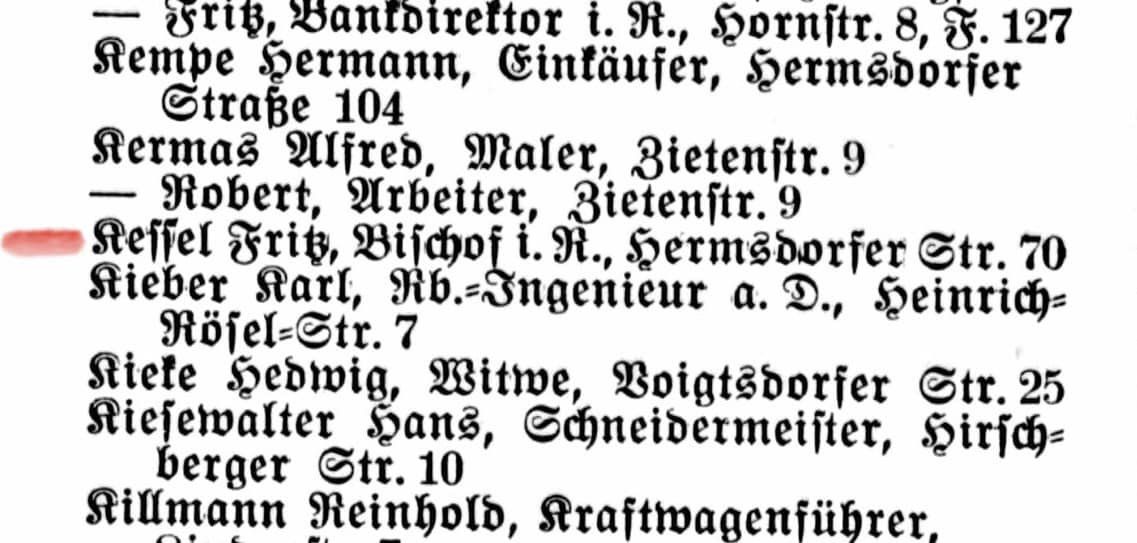In 1927, at 70 Hermsdorferstrasse in Bad Warmbrunn (now Cieplicka 70 in Cieplice Śląskie-Zdrój), lived Josef Galle, a senior tax secretary, Ernst Kuhlig, a chimney sweep, and Max Klein, a porter.

Contemporary view of the building / Photo by Marta Maćkowiak

The first page of Ernst Kuhlig’s marriage certificate / Source: Landesarchiv Berlin
In 1939, Agnes Ludwig, a widow, resides in the villa alongside Bishop Fritz Kessel, who will be staying there at least until 1941. Upon further investigation, it seems likely that this refers to the controversial clergyman who, among other things, co-founded the pro-Nazi religious movement known as Deutsche Christen (German Christians). Fritz Kessel, born on March 10, 1887, pursued studies in Protestant theology at Königsberg (Królewiec), Heidelberg, and Breslau (Wrocław).

Address book from Bad Warmbrunn, 1941
After his studies, he participated in World War I. In 1917, he was ordained as a priest, and three years later, in 1920, he was sent to Brazil where he served as a pastor in Badenfurt (Santa Carolina). After another three years, he moved to Rio de Janeiro, and in 1925, he returned to Germany. He then became a parish priest in Parchwitz (Prochowice), and in 1928, he additionally took on a role in the parish of St. Nicolai in Berlin-Spandau. In 1932, he co-founded the aforementioned Deutsche Christen movement, and in 1933, he was appointed Bishop of East Prussia with headquarters in Königsberg – against the will of Gauleiter Erich Koch.

Archival photo of the building / Source: Fotopolska eu
Contemporary view of the building / Photo by Marta Maćkowiak
Sources:
Końcowy raport składa się z kopi odnalezionych dokumentów, tłumaczeń, zdjęć oraz podsumowania. Wyjaśniam pokrewieństwo odnalezionych osób, opisuję sprawdzone źródła i kontekst historyczny. Najczęściej poszukiwania dzielone są na parę etapów i opisuję możliwości kontynuacji.
Czasem konkretny dokument może zostać nie odnaleziony z różnych przyczyn – migracji do innych wiosek/miast w dalszych pokoleniach, ochrzczenia w innej parafii, lukach w księgach, zniszczeń dokumentów w pożarach lub w czasie wojen. Cena końcowa w takiej sytuacji nie ulega zmienia, ponieważ wysiłek włożony w poszukiwania jest taki sam bez względu na rezultat.
Raporty mogą się od siebie mniej lub bardziej różnić w zależności od miejsca, z którego rodzina pochodziła (np. dokumenty z zaboru pruskiego, austriackiego i rosyjskiego różnią się od siebie formą i treścią).
Na podstawie zebranych informacji (Twoich i moich) przygotuję plan i wycenę – jeśli ją zaakceptujesz, po otrzymaniu zaliczki rozpoczynam pracę i informuję o przewidywanym czasie ukończenia usługi. Standardowe poszukiwania trwają około 1 miesiąca, a o wszelkich zmianach będę informować Cię na bieżąco.
Na Twoje zapytanie odpiszę w ciągu 3 dni roboczych i jest to etap bezpłatny. Być może zadam parę dodatkowych pytań, dopytam o cele albo od razu przedstawię propozycję kolejnych kroków.
Warto pamiętać, że im więcej szczegółów podasz, tym więcej rzeczy mogę odkryć.
Podziel się ze mną:
I najważniejsze – jeśli masz niewiele informacji, zupełnie się tym nie martw, w takich sytuacjach także znajdę rozwiązanie.